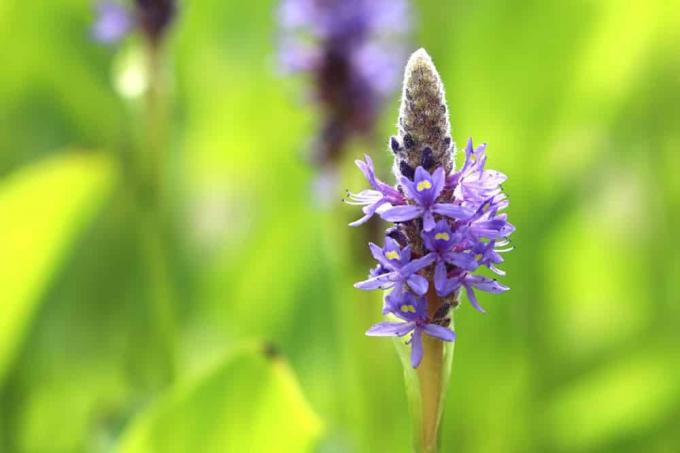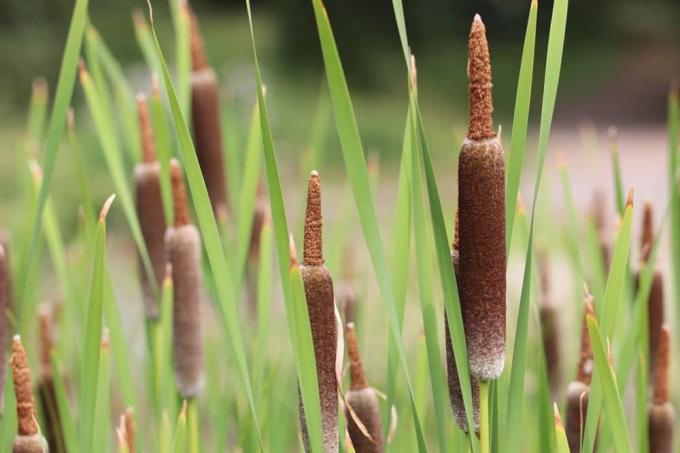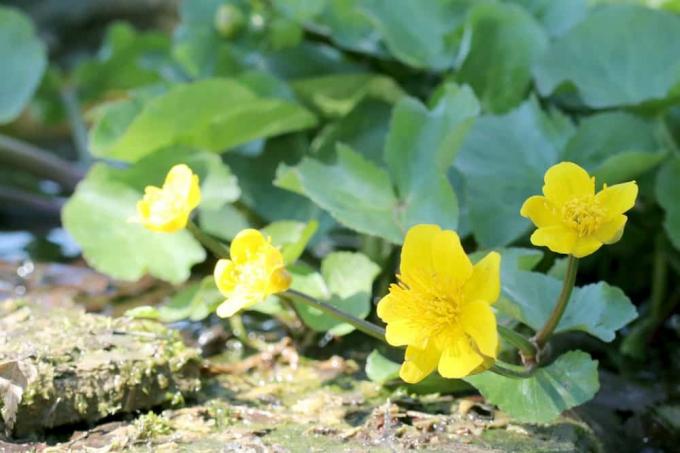

Table of contents
- The right location
- When to plant pike weed?
- Care
- flowering time of the pike weed
- cut
- Overwinter Pontederia cordata
- propagation
- Is pike weed poisonous?
- functions in the pond
- pests and diseases
Hechtkraut or Pontederia cordata, as the plant is called in botanical terminology, can grow in up to 30 centimeters deep water grow and therefore thrive especially on the shore areas of lakes and ponds. Here the plant fulfills important functions, such as acting against algae. But what do you have to pay attention to when caring for and overwintering and is the plant poisonous?
The right location
The plant needs a permanently wet soil, but should only be in a water depth of a maximum of 30 centimeters. Therefore, the plant is ideal for the bank area of the garden pond. It tolerates both full sun and partially shaded locations. Sandy, muddy and nutrient-rich soil should be used as substrate.
Tip:
If you want to prevent the Pontederia cordata from spreading too far, you can also place it in a planter in the pond. This limits the roots and allows more substrate to be made available to the plant.
When to plant pike weed?
Pontederia cordata should be used when the water surface is no longer likely to freeze over. In mild regions, this is already the case very early. A time between March and May is usually ideal.
Care

Of course, if the Pontederia cordata is in the water of the garden pond, it does not have to be watered. There is also no need for fertilization, as it is supplied with nutrients by other decomposing plants and, if necessary, by the faeces of fish and other pond inhabitants.
If, on the other hand, the herbaceous plant is cultivated in a bucket, you have to pay attention to various care steps. These include:
- Keep the substrate constantly wet or at least well moist
- use soft, low-lime water
- Use fertilizers specially designed for pond plants during the growth phase
Fertilization is carried out according to the manufacturer's instructions and depends on the selected fertilizer, but usually every two weeks.
flowering time of the pike weed
The flowering period of the Pontederia cordata usually falls between June and August. The plant has blue to violet spike-shaped flowers that are vaguely reminiscent of lavender and are extremely decorative. In addition to the attractive leaf shape and the practical functions in the pond, it is mainly due to the flowering time that the plant is one of the most popular plants for the garden pond.
Tip:
Flowering can be prolonged if a very sunny and sheltered location is chosen for the plant.
cut
At the end of the growth phase, the above-ground parts of the Pontederia cordata dry up and can then be trimmed. During growth, dried, broken or otherwise damaged parts of the plant should also be removed. This is particularly useful when cultivating in a pond, so that decomposing plant parts do not add more nutrients to the water.
Overwinter Pontederia cordata
Pike weed plants are not hardy and therefore do not tolerate frost. When the temperatures drop, the plant retreats into the so-called rhizome and the above-ground parts dry up or wither. For a successful hibernation, the following points should be observed:
- All dried parts of the plant must be removed. Scissors or a sharp knife should be used for this. In any case, the chosen cutting tool must be clean in order not to transmit diseases to the crop.
- Pontederia cordata is removed from the pond with the surrounding substrate. Again, it is practical if it was left in a planter. Otherwise, it should now be placed in a pot with the rhizome completely covered by soil.
- The plant is placed in a larger pot, bucket or in an aquarium and covered with soft, low-lime water.
- Hibernation takes place in a frost-free place. Temperatures between 5 and 10°C are ideal. Since the pike weed has withdrawn into the rhizome anyway, it can also hibernate in a dark room. Because the plant is not hardy, only the freedom from frost is decisive.
- During the winter, care should be taken that the substrate does not dry out and is constantly at least slightly moist. However, it may also be continuously covered with water. Watering should only be done with water that has the same temperature as the plant and substrate. It is ideal if it stands in the same room for at least a few hours and can thus assume the appropriate temperature.

In the spring, when the pond is no longer likely to freeze over, the plant can be placed back in the water outside. When cultivating in a tub, the last late frosts should be awaited, as the water surface freezes much faster in smaller containers than in a pond.
propagation
Pontederia cordata forms a so-called creeping rhizome and also multiplies over it. More sprouts emerge from the root. If the pike herb is to be propagated, they only have to be separated from the mother plant. The procedure is as follows:
- Remove the plant from the water and rinse the substrate from the roots.
- With a sharp, clean knife, divide the rhizome so that both mother and daughter plants get as much root mass as possible.
- Allow the interfaces to air dry for a few hours.
- Put the plants that have now been divided back into the substrate separately and plant them in the bank area or in containers.
The best time for propagation is when the daughter plants are already 10 to 20 centimeters high.
Another way to propagate the pike weed is to plant seeds. However, you have to wait much longer before the first young plants appear. Seeds can be harvested after flowering in summer and should be stored in a cool, dry place throughout the fall and winter. When the plants are ready to be put outside again, the seeds can also be placed in permanently wet soil and grown here.
Tip:
The young plants should also be planted directly in a container and not placed freely in the pond, thus, on the one hand, avoiding uncontrolled multiplication and, on the other hand, facilitating overwintering becomes.
Is pike weed poisonous?
No, neither the leaves nor the seeds of the plant are poisonous. Therefore, the plant is also suitable for the pond or bucket if children and pets use the garden to play and could accidentally tear off parts of the plant. In fact, the leaves and seeds of the Pontederia cordata are edible, so the plant can be cultivated without hesitation.
functions in the pond

The pike weed is not only extremely decorative with its leaves and flowers, but also fulfills important functions in the garden pond. For example:
Anti-algae action
Since the plant extracts nutrients from the water, it acts against algae or can at least reduce their spread.
Hiding places for pond dwellers
On the one hand, the stems and leaves of the plant offer hiding places for pond inhabitants, on the other hand they are also possible spawning grounds. This provides protection for the creatures in the garden pond.
Fortification of the bank area
The substrate is attached to the bank area by the creeping rhizome. However, this only applies if the plant is not cultivated in a container.
pests and diseases
Neither diseases nor pests have to be expected with the plant, because it is very robust and insensitive to infestation or infection. The only potential problem is found in aphids, which can cause damage to the leaves and stems. To combat this, there are, on the one hand, means from the specialist trade. However, a natural alternative can be found in predators such as ladybugs. These do not damage the plants and do not pose a threat to the water in the garden pond, but can also be bought from specialist retailers and used in a targeted manner. In addition, care should be taken to ensure that the plant is not hardy.
 garden editorial
garden editorial I write about everything that interests me in my garden.
Learn more about pond plants

Waterweed, Elodea densa - care from A to Z
Waterweed is one of the fast-growing aquatic plants that can adapt extremely well to a wide variety of water conditions. Not only does it do well in the garden pond, the Elodea densa can also be used in freshwater aquariums.

Marsh iris, Iris pseudacorus: care from A to Z
A pond is a special attraction in the garden and with the right planting it becomes an eye-catcher. A frequently used aquatic plant is the somewhat exotic-looking marsh or water iris. It is the perfect pond plant, which also has special properties.

Cattails: care from A-Z | 8 tips for propagation & cutting
The bulrush is a popular plant for natural gardens with large bodies of water. As marsh plants, the Typha species have special requirements for their location and care is more complex. With targeted measures and the right combination of species, you can reduce the maintenance effort.

Marsh marigold in the pond: location, care and propagation
The marsh marigold (Caltha palustris) is a real early bloomer and the first flowering plant in the garden pond. In spring it shows its bright yellow flowers, which illuminate the edges of ponds and water bodies as well as wet meadows. It is a good plant partner and very easy to care for.

Cut reeds, but when? Instructions + info at the best time
Green reeds are often planted because they grow incredibly fast. It will fill any suitable spot in just one gardening season. Sometimes, however, more stalks sprout than the gardener would like. When can he give the reed a short cut?

Gauklerblume - cultivation and care - is it hardy?
Juggler flowers form funny blossoms reminiscent of small faces. Native to the yellow-red range, they now also bloom in pink or blue. Some species love the moist environment and prefer to show off their color at the edge of the pond. A little care is enough for them.



